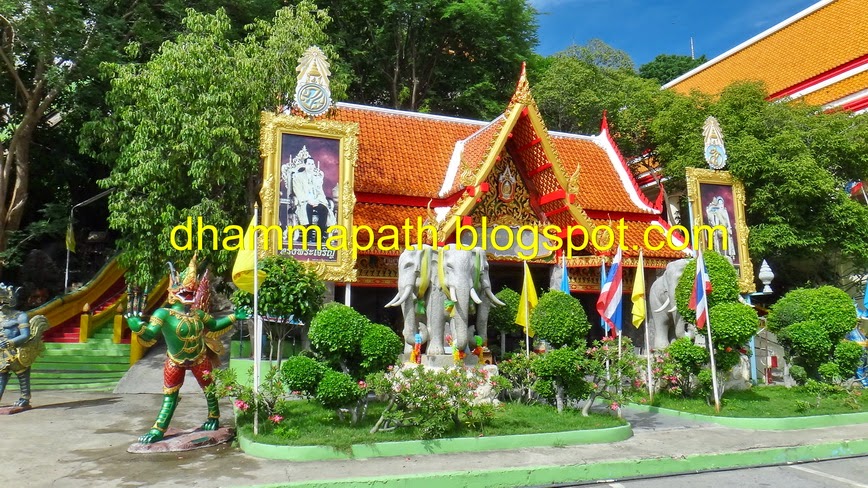The sacred Shrine of Thep Wittayakom with magnificent handcrafted design at Wat Banrai celebrates the very core of Buddhism in Nakhon Ratchasima. It's taken 3 years and a virtual army of artists and Buddhist faithful but at last Asia's largest ceramic mosaic shrine is finally complete. Towering over the Nakhon Ratchasima countryside, the 42 metre high, 4 storey Thep Wittayakom Shrine is designed to educate people about Buddhist teachings through the universal language of arts of architecture, paintings, and sculptures.
The photo taken at front side with Guardian Naga and the bridge. The whole Shrine is surrounded by water, the shrine relates the Tripitaka, Buddhism's sacred texts, in an artistic way that's easy to understand.Another Naga sculpture on the lake and another photo is main Ubosot of Wat Banrai.
Close view of the Naga (each 19 heads) with back side view.
Here we cross from the human world to the world of dhamma (Shrine Thep Wittayakom).
The main entrance with small pieces ceramic mosaic and the giant Elephant head at top. Ceramic has its own unique charm. The beauty lies in how the small, glossy pieces are laid next to one another in such a way that the resulting sculptures look special and gentle under the sun.
The 4 lintels with dedicated to the keepers of the world. The Indra arch represents the powerful god, the Phra Yom arch is named for the god of justice who decides who one can go to heaven. The Phra Piroon arch honours the god of water, abundance and tranquillity and the Phra Kuvane arch (Tao Wessuwan), represents the god of fortune who protects Buddhism and the earth.
The Naga coil around the shrine and the tails of both naga meet and coil three times to cover the ever-glowing wishing crystal, which symbolises the "3 practices" - sila (virtue), samadhi (concentration) and panya (discernment).
Another expansion building.
The back side entrance of the Shrine Thep Wittayakom.
The pillars around the building support the Erawan Elephant roof and are each illustrated with one of 523 previous lives of Lord Buddha. The mural on the exterior wall of the building presents 10 Jataka tales and was painted on ceramic before being fired at high temperatures.
The photo taken with one of the furious sculpture.
Inside the Ground floor with beautiful Murals.
The beautiful 6 murals have been meticulously painted by six artists, with the lotus symbolising Lord Buddha. In the hall, the Wishing Bodhi tree represents the meaning of Buddha - the enlightened, awakened and brightened one - and people are invited to make a wish. Here the visitors learn about the life of Lord Buddha from his birth to his Parinirvana (death).
Walking thru the corridor to roof floor with dhamma display.
The roof enshrines the 7 metre tall Phra Leela Buddha image in walking posture and the 5 metre tall metal statue of Luang Phor Koon Parisutho, which symbolises the Lord Buddha teaching dhamma to the monk so that he can in turn teach Buddhists.
The spectacular view from the roof for the whole temple and beyond.
Here is the basement of the Shrine Thep Wittayakom.
.
See more amulets from LP Koon - Wat Banrai at:
http://thaiamulets-dhammapath.blogspot.com/search/label/LP%20Koon
.
See more other Thai amulets at:
http://www.thaiamulets-dhammapath.blogspot.com/











.JPG)
.JPG)






















































